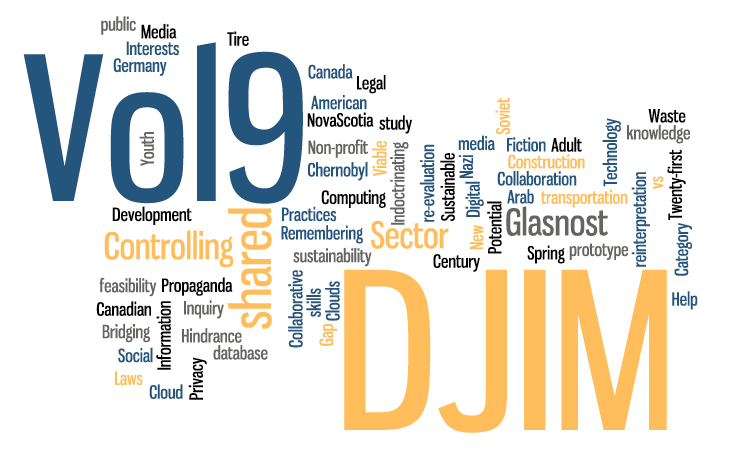Collaboration in the Nova Scotia Non-profit Sector: shared knowledge, shared skills, shared sustainability
DOI:
https://doi.org/10.5931/djim.v9i1.3364Keywords:
non-profit organizations, collaboration, Management without BordersAbstract
Non-profit organizations face many challenges such as unstable funding, high staff turnover rates and inadequate training. These challenges are further exasperated as the need for social services increases and governments continue to download more responsibility to non-profit organizations. Non-profit organizations need to collaborate with one another in order to overcome these challenges and address society‘s complex problems. Benefits of collaboration include the ability to share knowledge, skills and training and reduce redundancy in efforts, which would in effect increase the overall capacity of an organization and its attractiveness to funders. Challenges to collaboration involve building trust, communication and identifying common objectives and goals. However, this paper proposes that collaboration is possible in the Nova Scotia non-profit sector, through careful design in the preliminary stages of initiation and a focus on building trust and relationships. As such, a unified non-profit sector can be the solution to issues of sustainability currently being faced by these organizations.
References
Berger, P. L., Luckmann, T. (1967). The Social Construction of Reality. New York: Doubleday.
Berkes, F. (2010). Devolution of environment and resources governance: trends and future. Environmental Conservation, 37(04), 489-500. http://dx.doi.org/10.1017/S037689291000072X
Berlin, J. M., Carlström, E. D., & Sandberg, H. S. (2012). Models of teamwork: ideal or not? A critical study of theoretical team models. Team Performance Management, 18(5/6), 328-340.
Black Business Initiative. (2011). About BBI. Retrieved from http://www.bbi.ca/about-bbi/index.html
Byrd, J. T., & Luthy, M. R. (2010). Improving group dynamics: creating a team charter. Academy of Educational Leadership Journal, 14(1), 13-18.
CEED. (2012). About Us. Retrieved from http://www.ceed.ca/index.php?id=1.
Choo, Chun Wei. 2002. Knowledge Management. In J.R. Schement (Ed.), Encyclopedia of Communication and Information (pp. 501-506). New York: MacMillan Reference USA.
Gajda, R. (2004). Utilizing collaboration theory to evaluate strategic alliances. American Journal of Evaluation, 25(1), 65-77.
Galaskiewicz, J. (1985). Interorganizational relations. Annual review of sociology, 281-304. http://dx.doi.org/10.1146/annurev.so.11.080185.001433
Huxham, C., & Vangen, S. (1996). Working together: Key themes in the management of relationships between public and non-profit organizations. International Journal of Public Sector Management, 9(7), 5-17. http://dx.doi.org/10.1108/09513559610153863
Imagine Canada. (2010). A Framework for Action for the non-profit sector. Retrieved from http://www.imaginecanada.ca/files/www/en/publicpolicy/framework_for_action.pdf
Linder, S. H., & Rosenau, P. V. (2000). Mapping the terrain of the public-private policy partnership. Public-private policy partnerships, 1, 2-5.
Osborne, S. P., & Murray, V. (2000). Collaboration between non-profit organizations in the provision of social services in Canada: Working together or falling apart? International Journal of Public Sector Management, 13(1), 9-19. http://dx.doi.org/10.1108/09513550010334452
Parkin, C. (2006). Building successful collaborations: a guide to collaboration among non-profit agencies and between non-profit agencies and businesses. Retrieved from http://www.cfc-fcc.ca/link_docs/collaborationReport.pdf
Pfeffer, J., & Salancik, G. (1978). The external control of organizations: A resource dependence perspective. Stanford Business Books.
Phoenix and the Federation of Community Organizations (FOCO). (2012). At the Same Table: Developing the non-profit sector in Nova Scotia. Retrieved from http://www.foco.ca/online_documents/Documents%20-%2050664%20Phoenix%20final.pdf
Pisano, G. P., & Verganti, R. (2008). Which kind of collaboration is right for you? Harvard Business Review, 86(12), 78-86.
Sloan, P. (2009). Redefining Stakeholder Engagement: From Control to Collaboration. Journal Of Corporate Citizenship, (36), 25-40.
Smedlund, A. (2010). Characteristics of routine, development and idea networks in teams. Team Performance Management, 16(1/2), 95-117. http://dx.doi.org/10.1108/13527591011028942
Trist, E. L. 1983. Referent organizations and the development of interorganizational domains. Human Relations, 36:247-268. http://dx.doi.org/10.1177/001872678303600304
Waddock, S. 1991. A typology of social partnership organizations. Administration & Society, 22(4): 480-516 http://dx.doi.org/10.1177/009539979102200405
Willwerth, J., MacIntosh, J., Clarke, M., Travers, R., and Yao, Y. (2012). Innovative and Sustainable Fundraising Approaches for Non-profit Organizations. (Unpublished report). Dalhousie University, Canada.
Downloads
Published
Issue
Section
License
Papers published in the Dalhousie Journal of Interdisciplinary Management must be the original, unpublished work of the author. Contributors are responsible for obtaining any copyright clearances required in relation to their work.
Authors submitting a paper to the Dalhousie Journal of Interdisciplinary Management automatically agree to grant a limited license to DJIM if and when the manuscript is accepted for publication. This license gives permission for DJIM to publish the paper in a given issue and to maintain the work in the electronic journal archive. DJIM also submits issues to institutional repositories and Open Access repositories.
Contributors agree to each reader accessing, downloading, or printing one copy of their article for their own personal use or research. All other copyrights remain with the author, subject to the requirements that any republication of the work be accompanied by an acknowledgement that the work was first published in the Dalhousie Journal of Interdisciplinary Management and that the DJIM Editorial Chair must be notified of any republication of a work first published in DJIM.
Dalhousie Journal of Interdisciplinary Management
c/o School of Information Management
Faculty of Management
Dalhousie University
Kenneth C. Rowe Management Building
6100 University Avenue
Halifax, Nova Scotia B3H 3J5
Canada
Email: djim@dal.ca
Authors should recognize that, because of the nature of the Internet, the publisher has no control over unauthorized copying or editing of protected works.


